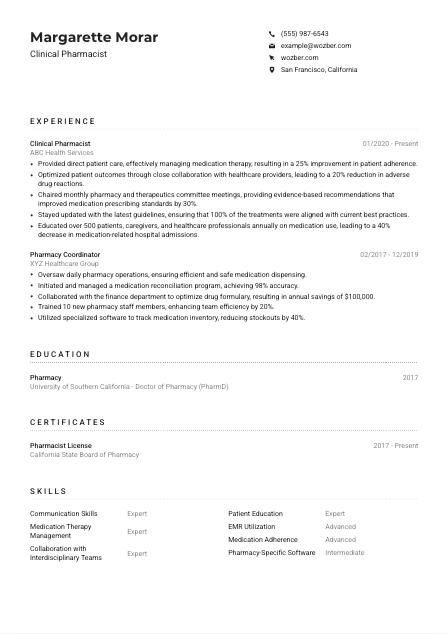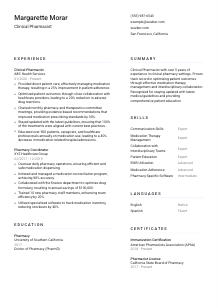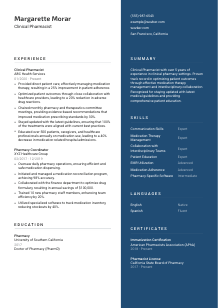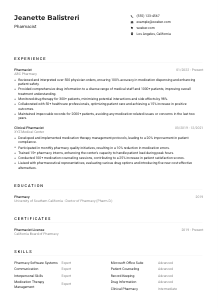Clinical Pharmacist Resume Example
Dispensing medications and dosages, but your resume feels like the wrong prescription? Refill your job prospects with this Clinical Pharmacist resume example, formulated using Wozber free resume builder. Learn how to compound your pharmaceutical expertise to meet job criteria, elevating your career from the generics to the specialties!

How to write a Clinical Pharmacist Resume?
Embarking on your journey to secure your next Clinical Pharmacist position? Your resume is the gateway to showcasing your expertise, experience, and the unique value you bring to a healthcare team. With precision akin to compounding a prescription, your resume must be tailored to fit the job you're aspiring for.
This guide, powered by the Wozber free resume builder, is your ally in constructing an ATS-compliant resume that speaks your language - the language of a dedicated Clinical Pharmacist. Let's transform your credentials into a compelling narrative that not only meets the job criteria but also optimizes your resume for Applicant Tracking Systems (ATS) using Wozber's ATS resume scanner.
Personal Details
The Personal Details section is your opportunity to introduce yourself in the professional realm. It's more than just a name on a page; it's about aligning your identity with the Clinical Pharmacist role you desire. By refining this section, you ensure your resume starts on the right note, clearly signaling to the hiring team that you're a prime candidate for the position.
1. Brand Yourself with Your Name
View your name as your personal brand. It's the first thing the hiring manager will see, so make it memorable. Consider using a slightly larger font to ensure it stands out, but keep it professional. Remember, a clear and readable typeface sets a positive tone for the rest of your resume.
2. Match the Position Title
Including your targeted job title immediately tells the hiring manager that your resume is crafted with a specific role in mind – in this case, "Clinical Pharmacist". Positioning it right below your name acts as a professional headline, summarizing your career objective in a snapshot.
3. The Essentials: Contact Information
Your contact information must be current and professional. A reliable phone number and a straightforward email format, such as firstname.lastname@email.com, ensure you're easily reachable for an interview invitation. Verify their accuracy to avoid accidental missed opportunities.
4. Location Matters
"Must be located in or willing to relocate to San Francisco, California." Stating your location meets a crucial job requirement and reassures the hiring team that there will be no relocation delays. Make it easy for them to see you're in the right place at the right time.
5. The Extra Mile: Professional Online Presence
A LinkedIn profile or a personal website can provide a deeper insight into your professional world. Include these links if they are polished and mirror the professionalism of your resume. This could set you apart and give you an extra edge in the selection process.
Takeaway
Your personal details are more than just basic information; they're the opening lines of your professional story. By tailoring this section with precision, you create a strong and positive first impression that aligns perfectly with the Clinical Pharmacist role. Remember, every element counts towards painting a comprehensive picture of who you are professionally. Let these details open the door to your future career opportunities.





Experience
The Experience section is where you shine, highlighting your journey and the significant impacts you've made in your field. As a Clinical Pharmacist, this is your chance to display your proficiency and dedication to patient care and interdisciplinary collaboration. Let's tailor this section to reflect your expertise and achievements in a way that resonates with the job requirements.
- Provided direct patient care, effectively managing medication therapy, resulting in a 25% improvement in patient adherence.
- Optimized patient outcomes through close collaboration with healthcare providers, leading to a 20% reduction in adverse drug reactions.
- Chaired monthly pharmacy and therapeutics committee meetings, providing evidence‑based recommendations that improved medication prescribing standards by 30%.
- Stayed updated with the latest guidelines, ensuring that 100% of the treatments were aligned with current best practices.
- Educated over 500 patients, caregivers, and healthcare professionals annually on medication use, leading to a 40% decrease in medication‑related hospital admissions.
- Oversaw daily pharmacy operations, ensuring efficient and safe medication dispensing.
- Initiated and managed a medication reconciliation program, achieving 98% accuracy.
- Collaborated with the finance department to optimize drug formulary, resulting in annual savings of $100,000.
- Trained 10 new pharmacy staff members, enhancing team efficiency by 20%.
- Utilized specialized software to track medication inventory, reducing stockouts by 40%.
1. Dissecting Job Requirements
Begin with a deep dive into each requirement listed in the job description. For instance, "Provided direct patient care...resulting in a 25% improvement in patient adherence" matches the responsibility to "Provide direct patient care, including medication therapy management." This meticulous alignment showcases your relevant experience.
2. Structure Counts
Present your roles in reverse chronological order, ensuring a clear, logical flow. Include the position title, the name of the organization, and your employment dates. This format is both ATS-friendly and easy for hiring managers to scan.
3. Detailed Accomplishments
Quantifying your achievements makes them tangible. For example, citing "Educated over 500 patients, caregivers, and healthcare professionals annually on medication use..." demonstrates your commitment to patient and healthcare provider education, directly mapping back to the job's responsibilities.
4. Quantify Where Possible
Numbers speak volumes. Including specifics like "Led to a 20% reduction in adverse drug reactions" provides concrete evidence of your contributions and outcomes. These measurable results can significantly bolster the persuasive power of your resume.
5. Relevance is Key
Your resume is a curated showcase of your professional narrative. Highlight experiences that reflect the core responsibilities and skills desired for the Clinical Pharmacist role. Extraneous information might dilute your message, so keep your content focused and impactful.
Takeaway
Your experience section is a powerful tool to communicate your journey and successes as a Clinical Pharmacist. By strategically aligning your accomplishments with the job requirements, you not only prove your suitability but also reveal your potential to excel. Remember, each entry is a chapter in your professional story - make it compelling, clear, and directly relevant to your next desired role.
Education
In the realm of healthcare and pharmacy, your educational background constitutes the foundation of your expertise. Even though it might seem straightforward, optimizing your Education section ensures that it underscores your qualifications for the Clinical Pharmacist role, projecting you as a knowledgeable and capable candidate.
1. Highlighting Essential Education
"Doctor of Pharmacy (PharmD) degree from an accredited institution." This precise degree is paramount for the Clinical Pharmacist role. Make sure this is prominently listed in your education section, directly reflecting the key and specific requirement from the job posting.
2. Simple and Clear
Maintain clarity and conciseness in your presentation. List the degree title, the educational institution, and your graduation year. This straightforward approach ensures your qualifications are easily assessed at a glance.
3. Degree Specification
For positions like Clinical Pharmacist, where specific academic qualifications are non-negotiable, your degree needs to precisely match the job listing. Adjust the terminology if necessary to ensure a perfect alignment, reinforcing your eligibility for the role.
4. Course Relevance
When applicable, including relevant coursework can enhance your profile, especially if you possess unique or specialized knowledge pertinent to the role you're targeting. For seasoned professionals, this may be less critical but can provide added context for early-career candidates.
5. Educational Honors and Achievements
If you graduated with honors, participated in relevant associations, or undertook significant projects or research, mention them. This adds a layer of distinction to your resume, illustrating dedication and excellence in your field. Gauge the relevance based on the role level and adjust accordingly.
Takeaway
While straightforward, the education section is a vital element of your resume, providing a foundation for your professional skills and knowledge. Tailor this section to address the specific educational requirements of the Clinical Pharmacist role, ensuring it underscores your qualifications and readiness. Remember, every detail counts in shaping the narrative of your career journey.
Certificates
In the constantly evolving field of pharmacy, certifications showcase your commitment to staying at the forefront of your profession. They can delineate your specialized knowledge and ongoing dedication to professional development. Let's explore how to effectively highlight your certifications on your resume, particularly those that amplify your suitability for the Clinical Pharmacist role.
1. Prioritizing Key Certifications
Start by identifying certifications directly related to the role. "Active, unrestricted Pharmacist license in the state of practice" is non-negotiable for a Clinical Pharmacist. This should be at the forefront of your certificates section, affirming your legal qualification for the role.
2. Focus on Relevance
While you may have numerous certifications, prioritize those most relevant to the Clinical Pharmacist position. Targeted information helps the hiring manager immediately recognize your fit and dedication to your specialization.
3. Date Transparency
Be clear about the validity of your certifications. For ongoing credentials, such as a Pharmacist License or Immunization Certification, note the active dates to confirm your current compliance and capability.
4. Commitment to Professional Growth
Your pursuit of professional certifications reflects a commitment to excellence and continuous learning in your field. Regularly review and update this section to include any new accomplishments, demonstrating your dedication to staying current and relevant in the clinical pharmacy landscape.
Takeaway
Certifications are a testament to your pursuit of excellence and ongoing professional development. By carefully selecting and presenting the certifications that best align with the Clinical Pharmacist role, you effectively showcase your readiness and dedication to the field. In the journey of your career, these certifications are badges of your commitment to exceptional patient care and professional growth.
Skills
The Skills section of your resume is a concise showcase of your professional capabilities relevant to the Clinical Pharmacist role. It's about painting a picture of the unique toolkit you bring to the table. Let's explore how to strategically select and present your skills to articulate your fit for the position and impress hiring managers.
1. Breaking Down the Job Requirements
Start by thoroughly analyzing the job description. Identify both hard and soft skills that are explicitly mentioned or implied. For example, "Strong interpersonal and communication skills" and "Proficiency in utilizing electronic medical records (EMR)" are crucial for the Clinical Pharmacist role and should be prominently featured in your skills section.
2. Targeted Skill Listing
Prioritize skills that align with the job description. By listing hard skills like "Medication Therapy Management" alongside soft skills such as "Collaboration with Interdisciplinary Teams", you address the multifaceted demands of the role, demonstrating both your technical proficiency and your ability to work effectively within a healthcare team.
3. Organization and Focus
Resist the temptation to list every skill you possess. Instead, focus on the skills most relevant to the job at hand. An organized, pertinent list tells the hiring manager that you understand the role's requirements and you're equipped to fulfill them.
Takeaway
Your skills section is a microcosm of your professional identity, reflecting the specific strengths you bring to the Clinical Pharmacist role. Tailoring this section to the job at hand ensures you present a cohesive and compelling view of your qualifications. Each listed skill is a beacon of your capability, so select and organize them with intention, showcasing your best professional self.
Languages
In today's globalized healthcare landscape, being multilingual can be a distinct advantage. While the primary focus for a Clinical Pharmacist may not always be on language skills, demonstrating your linguistic capabilities can highlight your versatility and readiness to interact with diverse populations. Let's dive into tailoring the languages section in a manner that adds value to your resume.
1. Aligning with Job Spec
"Advanced English speaking and comprehension skills required." In this scenario, English proficiency is non-negotiable. Place this at the forefront, categorizing your proficiency level accurately. This directly addresses a key requirement of the job.
2. Essential Languages First
List the languages essential for the position prominently. In this example, if you possess additional languages like Spanish at a fluent level, listing it after English could demonstrate added value, particularly if you're in a location like San Francisco with a diverse population.
3. Expanding Your Language List
Beyond the requirements, include other languages you're proficient in. This showcases your ability to communicate effectively in multicultural environments, a valuable asset in any healthcare setting.
4. Honesty in Proficiency
Clearly define your level of proficiency in each language using terms such as Native, Fluent, Intermediate, and Basic. Accurate representation ensures expectations are set correctly, and positions you as a trustworthy candidate.
5. Evaluating the Role's Scope
Consider the broader context of the role. Is there an international or multicultural aspect to the position? In such cases, your multilingual skills become even more significant, opening doors to wider communication and understanding in your patient care and team collaborations.
Takeaway
Your ability to communicate in multiple languages is not just an item on your resume; it's a testament to your ability to engage in a world that's increasingly interconnected. Highlight your linguistic skills confidently, considering them as tools that extend your professional reach and enhance your capability to provide inclusive patient care. Your linguistic prowess is another layer of your well-rounded professional identity.
Summary
Your summary is the initial handshake, the first opportunity to make an impression on the hiring manager. This concise section should encapsulate your career achievements, your strengths as a Clinical Pharmacist, and your professional demeanor. Let's craft a summary that's as potent as a well-formulated medication, delivering the essence of your professional identity in a few well-chosen sentences.
1. Digest the Job's Core
Deep dive into the job posting, absorbing the essence of what the role entails. Reflect this understanding by beginning your summary with a strong statement that positions you squarely in the realm of a Clinical Pharmacist, such as demonstrating your track record of optimizing patient outcomes through effective medication management.
2. Initial Professional Introduction
Initiate your summary with a bold statement of your professional identity. For instance, 'Clinical Pharmacist with over 5 years of experience in clinical settings' succinctly conveys your role and experience level, establishing a solid foundation for the summary.
3. Addressing Key Qualifications
Highlight your core competencies and achievements that align with the job requirements. Emphasize both your technical skills, like 'proficiency in EMR utilization,' and soft skills, such as 'effective collaboration with interdisciplinary teams', to present a balanced profile.
4. Conciseness is Key
The brilliance of a summary lies in its brevity and impact. Aim for a concise statement, 3-5 lines, that encapsulates your professional highlights and distinguishes you as a compelling candidate for the Clinical Pharmacist role.
Takeaway
Think of your summary as the prelude to your professional symphony. It sets the stage, engaging the hiring manager's interest and encouraging them to delve deeper into your resume. By crafting a summary that resonates with the needs and aspirations of the Clinical Pharmacist role, you position yourself as not just a candidate, but a frontrunner for the position. Let it be the hook that draws the reader into the depth and breadth of your professional narrative.
Embarking on Your Clinical Pharmacist Journey
Congratulations on completing this comprehensive guide! With these insights at your disposal, you're ready to craft a Clinical Pharmacist resume that stands out, addresses the nuances of the job, and passes through ATS filters with ease. Remember, your resume is more than a document; it's a reflection of your professional journey and a key to unlocking your next opportunity.
Use the Wozber free resume builder and its ATS resume scanner to ensure your resume is optimized and ready to make a lasting impression. The path to your next Clinical Pharmacist role is clear—move forward with confidence and commitment, and let your expertise shine.

- Doctor of Pharmacy (PharmD) degree from an accredited institution.
- Active, unrestricted Pharmacist license in the state of practice, or eligibility to obtain licensure in a timely manner.
- Minimum of 2 years of experience in a clinical pharmacy setting.
- Proficiency in utilizing electronic medical records (EMR) and pharmacy-specific software.
- Strong interpersonal and communication skills to effectively collaborate with interdisciplinary teams.
- Advanced English speaking and comprehension skills required.
- Must be located in or willing to relocate to San Francisco, California.
- Provide direct patient care, including medication therapy management, medication reconciliation, and medication therapy interventions.
- Collaborate with healthcare providers to optimize patient outcomes and ensure safe and effective drug therapy.
- Participate in pharmacy and therapeutics committee meetings, providing evidence-based recommendations.
- Stay updated with the latest guidelines and research in primary practice areas, ensuring treatment approaches are in line with current best practices.
- Provide patient, caregiver, and healthcare professional education on medication use, side effects, and drug interactions.















